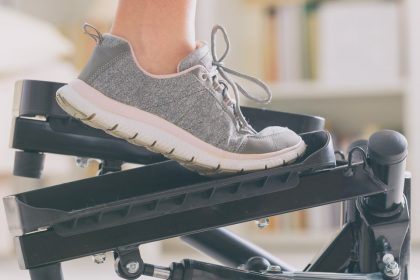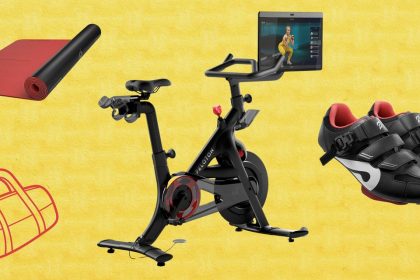Having a workout routine of any kind is an awesome way to reap some of the amazing benefits of exercise, like boosted mood, improved heart health, and better slumber. But if you’re looking to maximize the effectiveness of your sweat sessions? Well, that’s where the small-but-mighty details come in.
There are a bunch of little things people do during their workouts that can supercharge their goals—and some that are actually counterproductive to getting it done. And sorry, but chances are pretty good that you may be doing a bit of the latter. You likely aren’t even aware of it, but it’s something that personal trainers do pick up upon. After all, they’re there to help you get in the best workout possible, so they’ve got their eyes peeled for any of the tiny things that can throw a kink in it.
Some of these habits are super small, but they still deserve your attention—and a tweak or two. That’s because they can diminish the effectiveness of your workouts, up your chances of injury, and just plain make the whole experience less enjoyable. To help you avoid them, we tapped a few personal trainers for some of the common behaviors they’d really wish you skip. For your own good, promise!
1. Constantly scrolling your phone.
Pretty much all of us have our phones when we exercise—either because we’re actively using them in our workouts (say, to stream Spotify or follow a YouTube yoga flow) or because we’re just so used to toting them everywhere. The problem arises when it becomes a distraction from the task at hand. “When you’re just constantly scrolling and getting hooked up on Instagram and TikTok, or texting during your rest, that really disturbs and disrupts your workout focus and your flow,” Jasz Nesbitt, CPT, strength coach and Pilates instructor in Atlanta, tells SELF. This can mess with your workout plan by disrupting the flow of your reps and sets, and if you end up inadvertently taking more down time than intended, it can make it harder to get back in the groove.
It can also be…not great from a logistics standpoint, particularly if you’ve got a packed schedule and a timetable you need to stick to. “It increases the time that you are actually spending in the gym, and you’re not even working out, you’re just there,” Nesbitt adds. Basically, it drags out your workouts while simultaneously making them less effective. Definition double-whammy!
What to do instead: This habit can start out innocently enough—you see one Insta notification, and before you know it, you’re 20-minutes deep into doomscrolling—which is why Nesbitt suggests putting your phone on do not disturb before you start exercising. If the thought of being unreachable gives you anxiety, let the people in your life know it’s your gym time beforehand, and you’ll get back to them later. If you really cannot stand the thought of going on mute, at least set a timer for your rest periods so you know when to start moving again, Nesbitt suggests. That can nip TikTok bingeing in the bud. Another thing to consider: Try out a watch, like the Garmin Venu 3 or Apple Watch, that allows you to listen to music by synching with Bluetooth headphones. That way, you can reap all benefits of a motivating playlist without the distractions of your phone, which you can safely stash in the locker room while you break a sweat.
2. Picking up weights you’re not quite ready for…
Yes, lifting heavy is an awesome way to build muscle, improve your strength, and generally feel like a badass. But using weights that are too heavy can backfire by upping your chances of injury and reducing the effectiveness of the exercise, Nesbitt says. Take the squat for example: If you load up a barbell with way more poundage than you’re used to and then try to bust out a set of reps, you risk compromising your form (and you may also limit your range of motion in the process). These errors—think: rounding your back or letting your knees cave in—can cause certain joints and muscles to take on more force than they’re capable of handling, and ultimately up your likelihood of experiencing aches and injuries there. All the while, you’re not getting the intended benefits of the exercise because you’re not actually working the intended muscles, Nesbitt explains.
What to do instead: If you’re brand new to an exercise, start with just your bodyweight, Nesbitt says. Master good form there, and once you get to a point where doing 8 to 12 reps feels like a breeze, then add resistance. Choose a weight that allows you to complete all your reps with good form, with the last 2 to 3 reps feeling difficult but doable, she advises. Once that weight feels easy, level up again…but make each bump gradual. For upper-body moves, Nesbitt recommends increasing your weight in increments of 2.5 to 5 pounds at a time. For lower-body moves, the jump can be slightly larger—about 5 to 10 pounds at a time, she says.
3. …Or, on the flip side, grabbing the same dumbbells week after week.
Using the same exact weights every time is also not the best habit, since this shortchanges your progress. Certified personal trainer and corrective exercise specialist Jess Schneider, CPT at Life Time in Westchester, New York, tells SELF she sees so many people picking up weights that are too light for them, which limits their strength gains and ups the chances of plateauing. “We need something called progressive overload to get stronger and to build that muscle,” Schneider explains. This involves picking up increasingly heavy weights so that your muscles continue to be challenged, which is what they need to grow bigger and stronger
What to do instead: If you finish a set feeling like you could easily bust out 5 to 10 more reps with good form, that’s a sign to up your weight, Scheider says. It’s okay to feel like you have a little left in the tank when you finish a set (and in fact, it’s often a good thing to ensure you’re not pushing too hard and compromising your form), but this number should be countable on one hand.
4. Overcommitting to cardio.
Cardio is a stellar form of exercise, providing important heart healthy benefits. But so many people think that just hopping on the treadmill, elliptical, or stationary bike is going to help them achieve all their health and fitness goals. The truth? If you’re doing only cardio—and neglecting strength training—you’re really missing out. There are so many benefits to “having good, strong muscles,” Schneider says. Think: Stronger bones, reduced back pain, and even better blood sugar control if you have prediabetes, to name a few. That’s why the current Physical Activity Guidelines for Americans recommend both kids and adults slot in some sort of regular resistance training alongside cardio sessions. This holds true even if you have serious cardio goals—say, you’re a runner who is training for a big race—since incorporating resistance training alongside cardio sessions is still important for building well-rounded fitness. Plus, it can reduce your chances of injury and up your performance in the process, two legit gains you don’t want to leave on the table.
What to do instead: Ideally, your routine will include both strength and cardio. The “right” balance between the two depends on a number of factors, including your goals and health status, Schneider says. But in general, if you can prioritize strength training three times a week and then fit in light cardio sessions in between, that’s a great approach, Schneider says. If you don’t have that much time to devote to exercise, doing two days of strength and one day of cardio a week, or even one day of strength and one of cardio, is beneficial, Nesbitt says.
5. Bashing your abilities.
We can all be our own worst critics at times, but bringing this vibe into your workouts is not doing yourself any favors. Hearing negative self-talk in the gym is “frustrating,” certified personal trainer and performance coach Keith Hodges, CPT, founder of Mind In Muscle Coaching in Los Angeles, tells SELF. That’s because it can become a self-fulfilling prophecy: If you fill your mind with thoughts like I can’t do this or I’m never gonna reach my goals, “you’re programming your body and your brain to really believe this,” Hodges explains. And that can stop you from reaching your potential, since you’re basically throwing in the towel before you’ve even tried.
What to do instead: When you’re plagued by self-doubt, Hodges suggests taking a step back and asking yourself how you can know you’re incapable of doing something if you haven’t even attempted it. So long as you’re being safe and respecting your body’s limits, encourage yourself to simply try whatever it is that’s freaking you out—for example, that new Zumba class or an assisted pull-up. Don’t be afraid to fail, Hodges says, and approach new challenges as learning opportunities. With that mindset, you may just surprise yourself by what you’re capable of.
6. Comparing yourself to everyone on FitTok.
We’ve already talked about limiting scrolling during your workouts, but it’s also important to reflect on phone habits outside of the gym. Spend five minutes on FitTok and you’ll likely be bombarded with an idea of what “perfection” looks like in the exercise world, whether it’s someone’s elaborate crack-of-dawn workout routine, ability to bust out 50 perfect push-ups, or Cirque du Soleil level of mobility. But here’s the thing: Social media “sets unrealistic expectations,” Hodges says. And if you compare yourself to what you see online, “you’re never satisfied or excited or happy with your progress,” Hodges says. Ultimately, this can suck the joy out of your own fitness journey and make you less likely to stick with it for the long haul, since you’re left feeling like nothing you do is enough.
What to do instead: As unrealistic as social media can be, it’s also not really feasible to totally avoid it. “It’s just so embedded in society,” Hodges says. That said, you can remind yourself that there’s a lot you can’t discern from a photo or reel—like how truthful it is, how much it was edited, or even how much a person’s genetics influence what they’re capable of in the gym. Taking a step back and realizing that not everything online can (or should) be taken at face value can reduce those comparative thoughts. Also consider whittling down your follow list to remove accounts that make you feel bad…and then bolstering it with ones that make you feel good. That way, when you scroll, you’ll be less likely to fall into the comparison trap. (And if you think you—and your mental health—would benefit from a broader phone cleanse, we’ve got you covered.)
7. Not sticking with a program.
If you’re bored in the gym or just not seeing the progress you want, it’s only natural to switch things up. But injecting too much variety—for example, doing completely different workouts every session, or starting a new routine every two weeks—can actually hamper your results, Schneider says. That’s because you’re not taking the time to build any one skill, like perfecting the hinge movement pattern or nailing proper squat form, which is key if you want to keep challenging yourself and ultimately get stronger. “You’ll never really truly see the benefits of a good strength training regimen if you’re always changing things up,” she explains. Instead, “true strength, fitness, and health programming takes consistency and patience,” Schneider says.
What to do instead: Schneider recommends a strategy called undulating periodization: Basically, you do the same workouts for a four to six-week period. Each week, you repeat the same workouts, but strategically change one variable to ensure your body is continually challenged. This could be how much weight you’re using, the number of reps or sets, or the speed at which you’re performing exercises, she explains. After that four to six-week period, you should see results, at which point you can start the process all over again with a different set of workouts. Now, this may not be the sexiest approach, but it is effective. “There are lots of times where it’s going to be a little boring, and we just have to be okay with that,” Schneider says. Looking for inspo? Consider SELF’s 6 Weeks to Stronger program, which is centered on periodization and totally customizable to your goals and lifestyle. Here’s how to get started.
Related:
- 6 Small, Everyday Things Physical Therapists Wish You’d Stop Doing
- 15 Resistance Band Exercises to Work Your Entire Body
- 25 Signs You Crushed Your Workout That Have Nothing to Do With Sweat or Soreness
Get more of SELF’s great fitness coverage delivered right to your inbox—for free.







